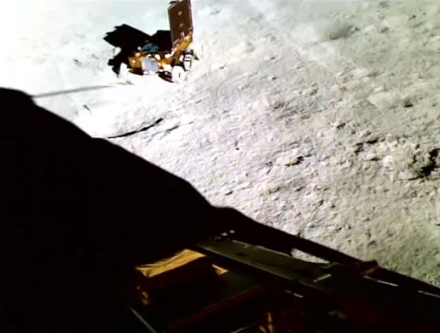ESA successfully test fires upper stage engines of new Ariane-6 rocket
Despite delays in test firing the first stage engines on ESA’s new Ariane-6 rocket, it has successfully tested fired the rocket’s upper stage engines in Germany.
The test of the full upper stage – including the new Vinci engine and a smaller Auxiliary Power Unit (APU) – took place on a purpose-built test bench at German Aerospace Center DLR’s engine test centre in Lampoldshausen, Germany.
Vinci, the upper stage engine of Ariane 6 fed by liquid hydrogen and oxygen, can be stopped and restarted multiple times – to place satellites into different orbits and then de-orbit the upper stage, so it is not left behind as hazardous debris in space. The APU makes it possible for Vinci to restart in space, by maintaining adequate pressure in the fuel tanks and preventing bubbles in the fuel lines. The APU uses small amounts of liquid hydrogen and oxygen from the main tanks – replacing a system which relied on large quantities of tanked helium.
A last hot-fire test is scheduled before final qualification of the Ariane 6 upper stage, with the aim of testing its operation for different types of missions, as well as in degraded conditions.
Meanwhile, the next attempt to do the same with the first stage in French Guiana is scheduled to take place on September 5th.
Despite delays in test firing the first stage engines on ESA’s new Ariane-6 rocket, it has successfully tested fired the rocket’s upper stage engines in Germany.
The test of the full upper stage – including the new Vinci engine and a smaller Auxiliary Power Unit (APU) – took place on a purpose-built test bench at German Aerospace Center DLR’s engine test centre in Lampoldshausen, Germany.
Vinci, the upper stage engine of Ariane 6 fed by liquid hydrogen and oxygen, can be stopped and restarted multiple times – to place satellites into different orbits and then de-orbit the upper stage, so it is not left behind as hazardous debris in space. The APU makes it possible for Vinci to restart in space, by maintaining adequate pressure in the fuel tanks and preventing bubbles in the fuel lines. The APU uses small amounts of liquid hydrogen and oxygen from the main tanks – replacing a system which relied on large quantities of tanked helium.
A last hot-fire test is scheduled before final qualification of the Ariane 6 upper stage, with the aim of testing its operation for different types of missions, as well as in degraded conditions.
Meanwhile, the next attempt to do the same with the first stage in French Guiana is scheduled to take place on September 5th.















